Often well-camouflaged, there are plenty of birds that are active at night in Florida!
Examples of nocturnal birds in Florida include the barn owl, yellow-crowned night heron, Antillean nighthawk, great horned owl, chuck-will’s-widow, and many others.
Do some of them sound familiar? Let’s jump in and see what each of these looks and sounds like!
Table of Contents
Nocturnal Birds In Florida
Common Nighthawk

- Scientific Name: Chordeiles minor
- Length: 8.7-9.8 in
- Wingspan: 20-24 in
- Weight: 1.9-3.5 oz
These medium-sized birds with split tails and long, pointed wings are crepuscular and nocturnal raptors found throughout Florida during summer.
After breeding in the state, common nighthawks will begin their 1,600-4,200 mile-long journey to South America.
In case you decide to go looking for them, keep in mind that they are well-camouflaged and blend excellently with the environment during the day.
Their plumage is usually gray, black, and brown with white wing patches close to the base of primary feathers.
Source: Unknown author, Public domain, via Wikimedia Commons
There are 9 recognized subspecies of common nighthawks. They are common around prairies, forests, savannahs, and urban areas, where they feed on large insects during the night.
During summer evenings, watch and listen for their “booming” flight displays where they fly slightly above trees before diving down for the ground. Their wingtips will make deep booms, similar to racing cars passing by.
Read More: Examples of nocturnal birds of Oklahoma
Antillean Nighthawk
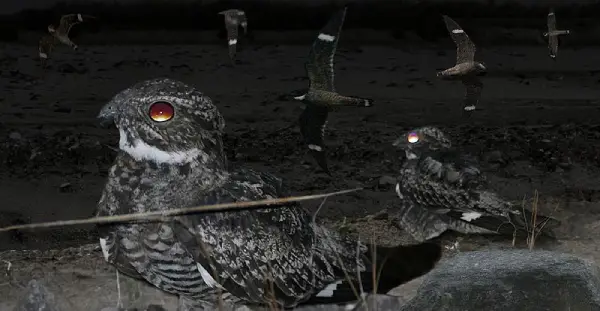
- Scientific Name: Chordeiles gundlachii
- Length: 8 in
- Wingspan: 20-22 in
- Weight: 2 oz
Antillean nighthawks are nightjars native to the Florida Keys and the Caribbean.
Part of their scientific name “gundlachii” is after the Cuban naturalist Juan Gundlach.
These long-winged night birds come in two morphs, grayish and tawny. Notice the white patch across their wings.
They look very similar to common nighthawks but can be distinguished by their calls – Antillean nighthawks will make a series of hard buzzy “drik-rik-rik” sounds.
In their Florida range, they inhabit disturbed areas or wide-open “developed” land such as airports and vacant lots where they can nest on the ground and hunt insects, especially moths and beetles.
A nocturnal species, but can be also seen hunting around dusk and dawn, grabbing their prey as they fly.
Chuck-will’s-widow
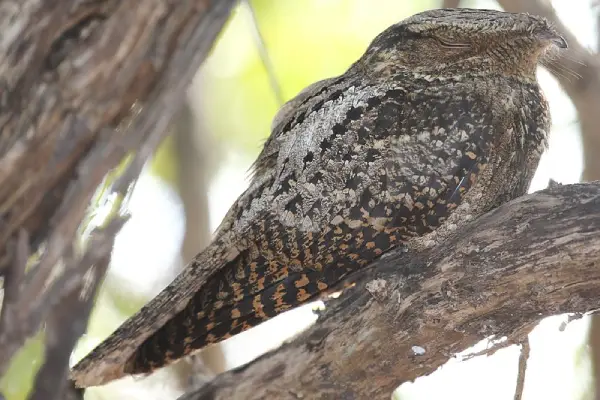
- Scientific Name: Antrostomus carolinensis
- Length: 11-13 in
- Wingspan: 23-26 in
- Weight: 2.3-6.6 oz
Chuck-will’s-widows are large night birds with big heads, short bills, and long tails.
In southern parts of Florida, from Okeechobee to the Keys, they can be seen year-round; in northern parts of the state, they only come to breed during summer.
Their plumage varies from grayish to rufous with intricate patterns, camouflaging them well in the trees.
Chuck-will’s-widows are nocturnal, calling and hunting at dusk, predawn, and at night – you might have spotted them in your headlights while driving as they love to sit on the roads and roadsides at night.
These birds hunt for insects when the sun sets and are particularly fond of moths, beetles, and winged ants.
They were named after their distinctive whistled songs that sound like “chuck-wills-widow“.
Source: James G. Howes, Public domain, via Wikimedia Commons
Chuck-will’s-widows are migratory and resemble eastern whip-poor-wills and common nighthawks.
Read More: What birds sing at night in South Carolina?
Eastern Whip-poor-will
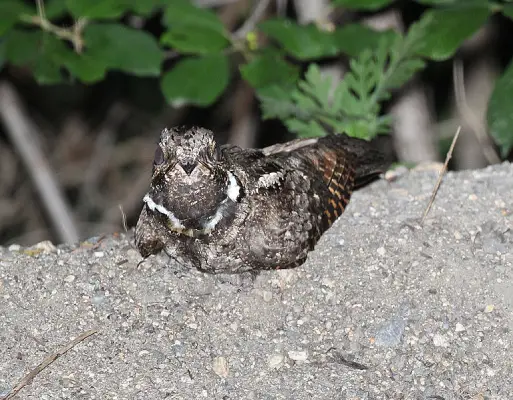
- Scientific Name: Antrostomus vociferus
- Length: 8.7-10.6 in
- Wingspan: 17.7-19.6 in
- Weight: 1.5-2.4 oz
After breeding in the northeastern parts of North America, eastern whip-poor-wills migrate to Florida, Mexico, and most of Central America.
Found throughout Florida during winter, whip-poor-wills are common in forests with open understories.
These cryptic nocturnal birds are easier to hear than to see as they remain motionless and sleep during the day.
The best way to identify them is by their song – a whistled “whip-poor-will” that is emitted in forests with open understories they inhabit.
Source: G. McGrane, Public domain, via Wikimedia Commons
Eastern whip-poor-wills have mottled plumage with a mixture of brown, black, and gray that camouflages them well with their environment.
They hunt at night, feeding on flying insects they catch from the ground. Eastern whip-poor-wills closely resemble chuck-will’s-widows who have slightly larger heads and longer wings and tails.
Barn Owl
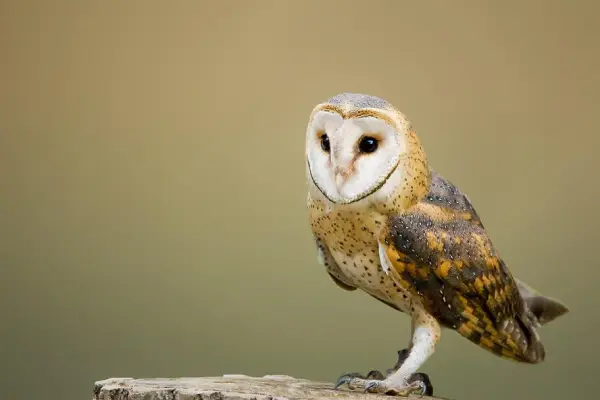
- Scientific Name: Tyto alba
- Length: 13-15 in
- Wingspan: 31-37 in
- Weight: 9-19 oz
One of the most widely distributed species of owl in the world, barn owls are highly elusive raptors found around open fields, riparian areas, and farms.
These medium-sized owls have heart-shaped heads, cinnamon and gray upperparts, and white underparts. They often have a “ghostly” appearance, especially if seen at night.
Barn owls are found year-round throughout Florida.
Females tend to be slightly bigger than males; the species have smaller tails compared to other Florida owls.
Barn owls do not hoot and make bone-chilling screams instead. They hunt for rodents during the night and roost in nest boxes, caves, tree hollows, and old buildings.
Source: Luis Gracia, CC BY-SA 4.0, via Wikimedia Commons
They are quite common in the USA and are among many birds that can be seen in southern California, northern California, east Tennessee, west Washington, etc.
Eastern Screech-owl

- Scientific Name: Megascops asio
- Length: 6.3-10 in
- Wingspan: 18-24 in
- Weight: 4-8 oz
Eastern screech owls are small and stocky owls with big heads, large yellow eyes, often-raised small ear tufts, and horn-colored beaks.
They are found throughout Florida in different habitats ranging from swamps to pine and oak forests, and urban and suburban areas.
One of the smallest species of owl you’ll find in Florida, eastern screech-owls come in two colors: mostly gray or mostly reddish-brown. Regardless of the overall color, they are patterned with complex bands and spots that help camouflage these birds against tree bark.
These tiny owls are easier to hear than to see – they are most active at night when they hunt insects, small mammals, and birds. Their big eyes and sharp vision come in very handy for picking up small movements at night.
Source: Jonathon Jongsma, CC BY-SA 3.0, via Wikimedia Commons
Out of all North American owls, they are the most strictly nocturnal.
Eastern screech-owls are also one of the most common birds found in northern parts of Georgia.
Great Horned Owl

- Scientific Name: Bubo virginianus
- Length: 17-25 in
- Wingspan: 35.8-60.2 in
- Weight: 2.7-3.5 lb
Also known as the tiger owl, the great horned owl is the largest owl species found throughout Florida.
It is also one of the largest owls in North America and has a lifespan from 15 to 25 years in the wild.
Great horned owl inhabits mountains, grasslands, conifer forests, deserts, chaparrals, and many other areas.
Great horned owls hunt using their acute hearing and excellent eyesight and can fly in near silence to catch their prey by surprise. In case you see great horned owls in person, you will notice gray-brown plumage with a mottled pattern, long, earlike tufts, intimidating yellow eyes, and a deep hooting call.
Source: Michael & Katie LaTour, CC BY-SA 4.0, via Wikimedia Commons
Great horned owls are monogamous birds and may stay together for over five years, sometimes even for a lifetime.
Burrowing Owl
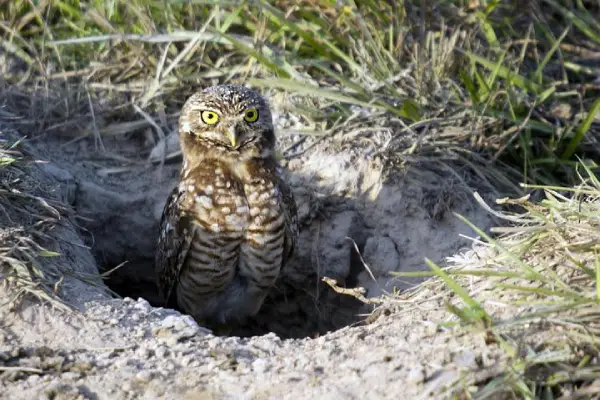
- Scientific Name: Athene cunicularia
- Length: 7-11 in
- Wingspan: 20-24 in
- Weight: 5-8 oz
Burrowing owls are the native birds of Florida.
They are also the only owl species that nest underground.
You will identify them in person by their bright eyes, long grayish legs, and lack of ear tufts. These owls have brown heads and wings with white spots and white bellies.
Burrowing owls are permanent residents of Florida and can be seen there around open areas with no trees, including grasslands, rangelands, agricultural areas, and deserts.
They breed in the state from February to July. They mate for life and lay 4-12 eggs that females incubate while the males feed them.
Burrowing owls aren’t very vocal but will still make various sounds: clucking, screaming, rattling, etc. They will often make a two-note cooing call when mating or defending territory.
These Florida natives spend most of their time on the ground; thanks to their long legs, they can have a good view of the horizon.
Burrowing owls are small birds of prey that feed on insects, snakes, frogs, rodents, lizards, and birds.
When the breeding season comes, they become more active during the day; as the non-breeding season comes, they are more nocturnal.
Read More: What birds sing at night in Louisiana?
Barred Owl
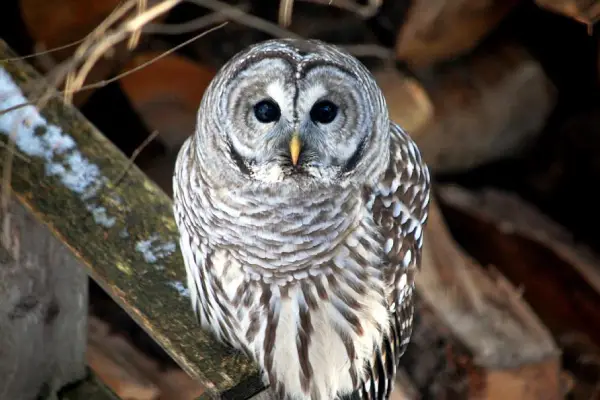
- Scientific Name: Strix varia
- Length: 16-25 in
- Wingspan: 38-49 in
- Weight: 1.3-2.5 lb
Known under several names (northern barred owls, striped owls, or more informally, hoot owls), barred owls are large birds with mottled brown and white colors.
They can be identified by their yellow beaks, absence of ear tufts, and nocturnal hoots that sound like “who cooks for you, who cooks for you all” and that can be heard almost half a mile away.
Source: Jonathon Jongsma, CC BY-SA 4.0, via Wikimedia Commons
Barred owls can be seen year-round throughout Florida, mostly around woods and swamps. There they hunt small prey such as insects, small mammals, crayfish, and crabs.
Just like in Oregon, they are mostly active at night but might occasionally call and hunt during the day.
In Florida, they usually breed from late January to March.
Barred owls will nest in tree holes or use abandoned nests of other animals, from red-tailed hawks to squirrels. After they establish nests, they become very territorial and aggressive – they will chase away intruders by hooting aggressively or attacking them with their sharp talons!
Read More: Examples of night birds of Indiana
Short-eared Owl

- Scientific Name: Asio flammeus
- Length: 13-17 in
- Wingspan: 33-43 in
- Weight: 7.3-16.8 oz
Short-eared owls are found on all continents except Antarctica and Australia, making them one of the most widespread bird species.
In Florida, these nocturnal owls are non-breeding residents of the state and can be seen during the winter there.
They mostly inhabit open grasslands, including weedy fields, grass strips of small airports, coastal marshes, and even agricultural fields with stubble.
Short-eared owls are mottled brown above, whitish below, and have very short ear tufts and black beaks. They also have large yellow eyes that are accentuated by black rings, making them look like they are wearing mascara!
Although mostly silent, short-eared owls will make a series of “voo-hoo-hoo” calls during the breeding season.
Source: Jamescandless, CC BY-SA 3.0, via Wikimedia Commons
They are generally nocturnal when most of the hunting happens, but they can also be crepuscular (active near dawn and dusk) and even diurnal (to a much lesser extent).
These owls are migratory birds that feed mostly on voles, rats, bats, mice, squirrels, rabbits, and some birds.
Fun Fact: Short-eared owls are fearless birds that will often harass falcons, herons, and eagles, just for fun!
Read More: What birds sing at night in Alabama?
Black-crowned Night Heron
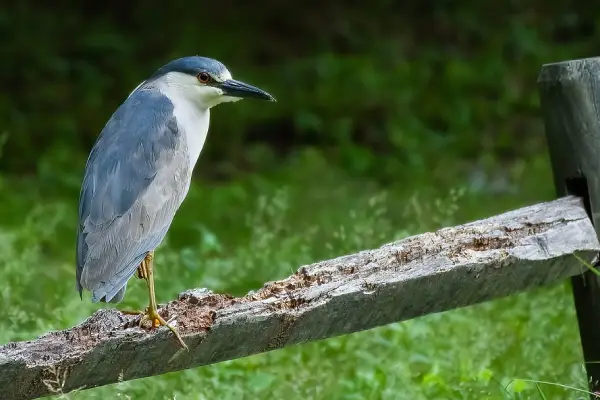
- Scientific Name: Nycticorax nycticorax
- Length: 22.8-26 in
- Wingspan: 45.3-46.5 in
- Weight: 25.6-35.8 oz
Black-crowned night herons are pale grayish birds with large heads, black caps, short legs, and red eyes. They often hold their short necks tucked in which gives an impression of a stocky build.
Also known as black-capped night herons, they are one of the most widespread heron species in the world.
In Florida, black-crowned night herons are permanent residents and can be seen year-round in the state. They inhabit wooded swamps, ponds, lakes, and mangroves.
Unlike most of their long-legged heron relatives, black-crowned night herons are most active at night or at dusk, when they feed on fish, frogs, small mammals, young waterbirds, insects, snakes, and even garbage at landfills.
Black-crowned night herons are one of several heron species that will “bait fish” – throw some food in the water to lure the fish before striking them with their long beaks. These nocturnal and noisy herons will also migrate in large flocks exclusively during the night.
Part of their scientific name “Nycticorax” comes from ancient Greek and means “night raven”, referring to their nocturnal feeding habits and croaking crow-like calls.
Source: Jonathon Jongsma, CC BY-SA 3.0, via Wikimedia Commons
Read More: Night birds found in Michigan
Yellow-crowned Night Heron

- Scientific Name: Nyctanassa violacea
- Length: 21.6-27.6 in
- Wingspan: 39.7-44 in
- Weight: 1.4-1.8 lb
Yellow-crowned night herons are stocky wading birds with long necks, large heads, and long black beaks. These enormous blue birds can have a wingspan of up to 3 ft 8 in and weigh up to 1.8 pounds.
Yellow-crowned night herons are smooth gray-blue with bold black-and-white head patterns. They also have pale yellow crowns on their heads, giving them their common name.
Yellow-crowned night herons are summer residents in central and northern parts of Florida; in southern parts of the state, they can be seen year-round. Their breeding season typically lasts between March and May.
They are vocal birds with many sounds. Their most common alarm call is a loud and sharp “quawk.” Males and females may also use “yup-yup” and “huh” calls during courtship.
Despite being occasionally seen during the day, yellow-crowned night herons are mainly nocturnal birds.
They tend to roost in trees during the day and feed during the night, mainly on crabs and crayfish.
They can be often seen walking slowly or standing still in shallow waters, waiting for their prey to approach. Yellow-crowned night herons might also consume some insects, fish, worms, lizards, snakes, small rodents, and even small birds.
Read More: What birds sing at night in New York?
American Woodcock

- Scientific Name: Scolopax minor
- Length: 10-12 in
- Wingspan: 16.5-18.9 in
- Weight: 5-8 oz
American woodcocks are small shorebirds found throughout Florida. These migratory birds will spend summer in the northern parts of the state and then migrate to south Florida for the winter.
They mainly inhabit brushy and young-forested habitats and are easy to spot by their large heads, short necks, and short tails. Their plumage is a mix of browns, grays, and blacks.
American woodcocks also have very long, straight, and prehensile beaks. During the night, they spend their time probing the soil in pursuit of earthworms and other invertebrates.
Source: Jonathon Jongsma, CC BY-SA 3.0, via Wikimedia Commons
Thanks to the unique beak structure, woodcocks can open and close the tips of their upper bills while they are sunk into the ground.
American Woodcock also migrate at night and might hit windows, communications towers, and other structures.
Because of their nocturnal lifestyle, inconspicuous colors, and low-profile behaviors, American woodcocks are usually very hard to spot. Around dusk and dawn during springtime, you might manage to find males showing off with their stunning aerial displays.
They are also known as timberdoodles, bogsuckers, and hokumpokes and have unique and large eyes that allow them to see 360° horizontally and 180° vertically.
American woodcocks are popular game birds, with over half a million birds caught annually by hunters.
Read More: What are some of the smallest white birds in Florida?
Summary
There are over 530 species of birds in Florida – many of them are active during the night.
Some can be seen year-round there, like several owl species, while others, like common nighthawks, visit the state only to breed. In case you’ve stumbled upon any of these birds, we hope this guide helped you identify which ones they were.
Feel free to read our other popular articles on birds: examples of nocturnal birds of Texas and examples of nocturnal birds of Ohio